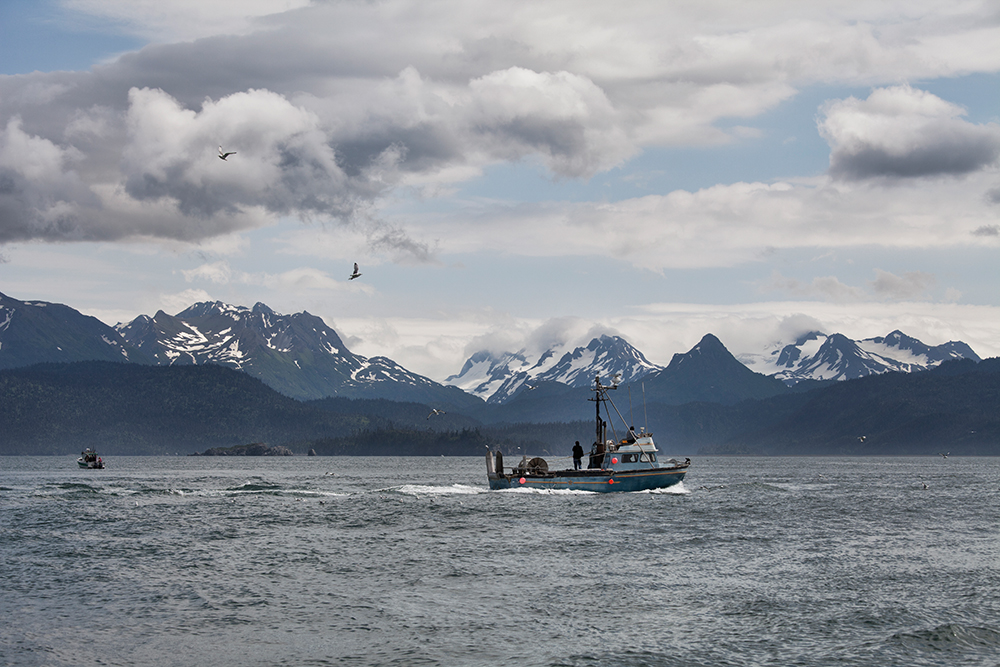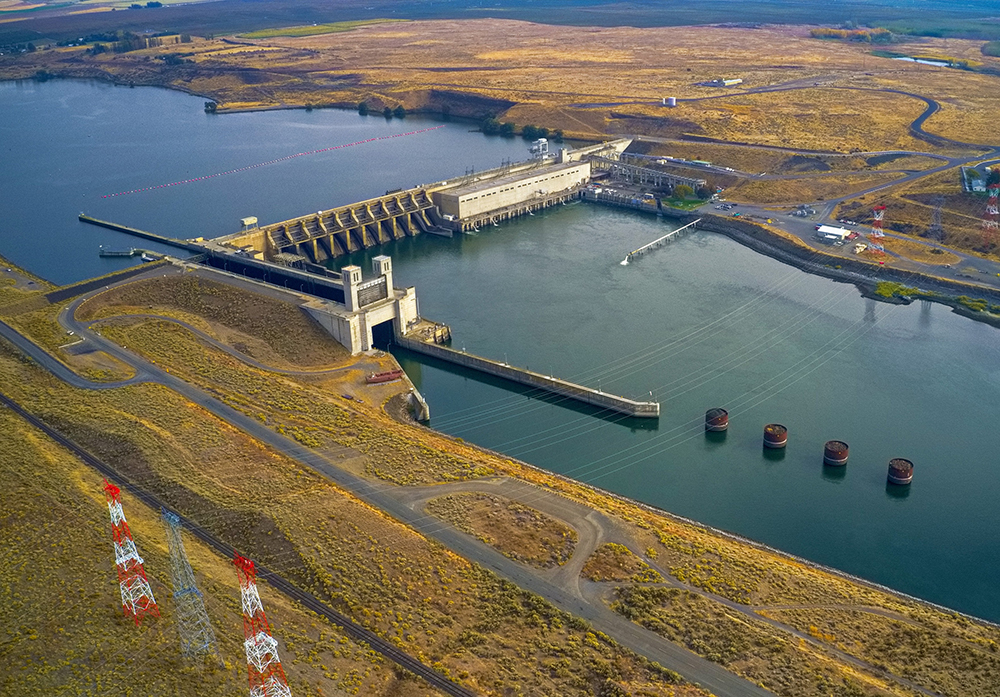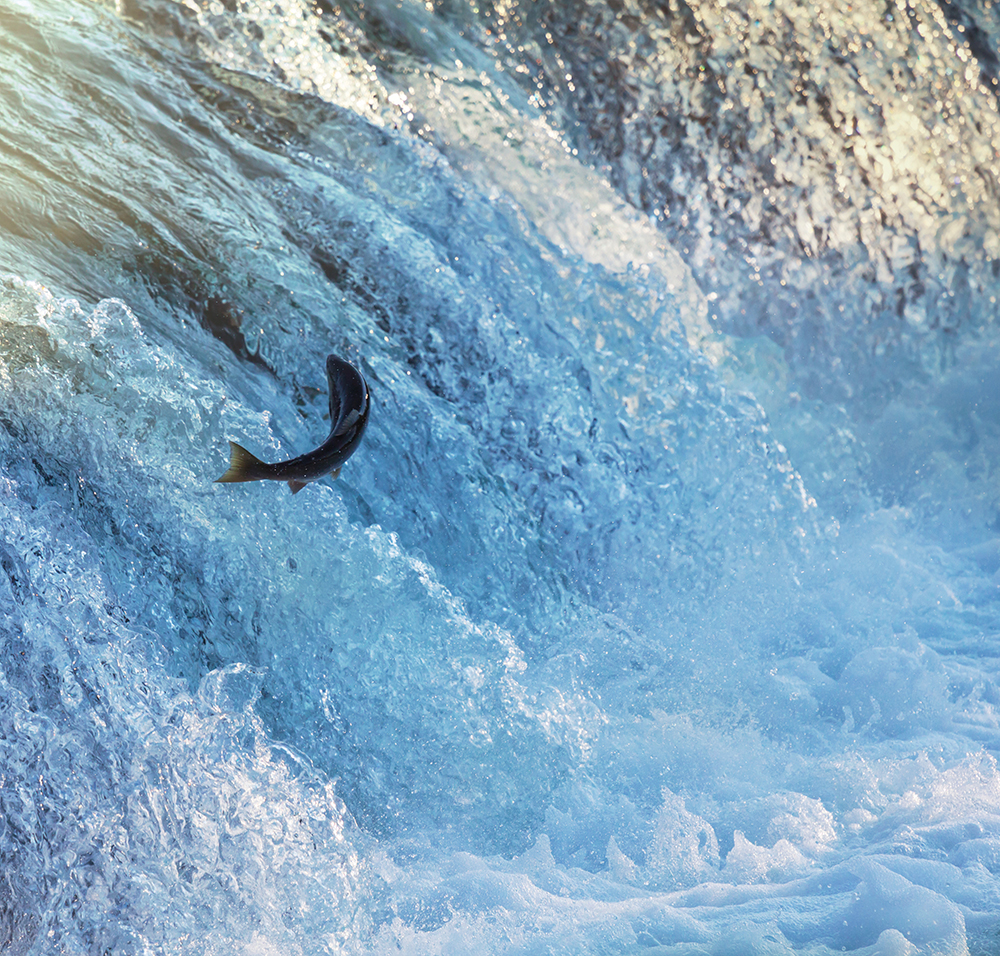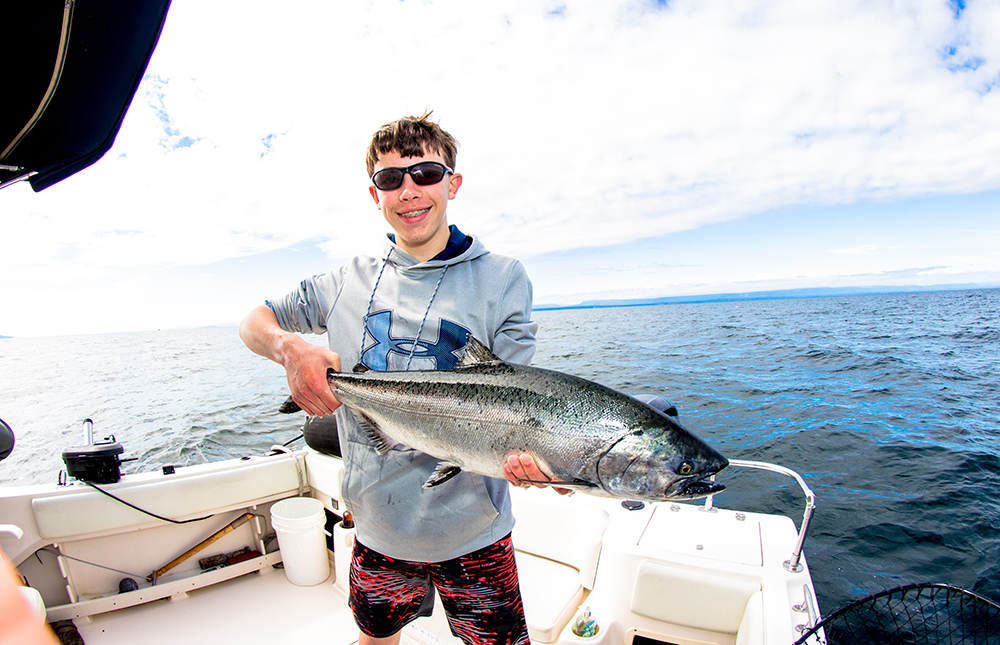Dr David Welch – Rethinking Strategies for Increasing Salmon Survival
It’s a long-held belief that a series of dams in the Snake River in Northwest USA constructed nearly 50 years ago has led to serious declines in Chinook salmon populations. However, new research by Dr David Welch and his team from Kintama Research Services Ltd shows that survival of Chinook salmon measured by a wide range of government agencies has fallen by 65% along the whole North American West Coast over this period. These results have significant implications for informing conservation strategies to protect and restore this important species.
Salmon Populations in Trouble
The abundance of salmon in the North Pacific has reached record levels. However, most of this increase is in just two species – pink and chum salmon – in far northern regions, attributed in part to ocean ranching – a type of fish farming where juvenile fish reared in hatcheries are released into the ocean to grow before harvest.
In contrast, all West Coast North American Chinook salmon populations are experiencing serious declines. The situation is similar for most southern populations of coho, sockeye, and steelhead salmon. These dwindling species are of higher economic value and are the focus of many indigenous, sport, and commercial fisheries.
Chinook salmon are native to the North Pacific Ocean and the river systems of western North America, ranging from California to Alaska. They are born in freshwater and can undertake complex movements among a variety of freshwater habitats to find food before migrating to the sea as ‘smolts’. They then spend multiple years at sea before returning to their natal freshwater habitat to spawn and die.
In North America, declines in salmon populations since the 1970s were originally assumed to be caused by humans modifying freshwater habitats in the populous southern regions, which initially saw the greatest decrease. On the Snake River, the largest tributary of the Columbia River, many dams have been constructed between its headwaters in the Rocky Mountains to where the Snake joins the Columbia River mainstem. It is widely believed that these dams are a major factor behind population declines in Chinook salmon in the Columbia River Basin. The poor survival of Snake River Chinook salmon has resulted in them being listed under the US Endangered Species Act.
In order to examine the large-scale patterns of Chinook salmon survival from the Snake River and other regions, Dr Welch and his colleagues at Kintama Research Services Ltd have been analysing government data to compare the ‘smolt-to-adult return rate’ for Chinook salmon from central California to southeast Alaska. The team used the results to examine existing theories around population decreases, and to question whether current management practices are appropriate.

Challenging Existing Theories
One long-held theory is that the survival of Snake River Chinook is low because poor survival at sea is caused by ‘delayed mortality’. In a nutshell, the theory argues that ocean survival is bad partly because of the many dams the young fish had to migrate through to get there. However, the new data analysis by Dr Welch and his team indicates that Chinook salmon declines are similar from California to Alaska – and most of these river basins have no dams.
‘Our analysis of all the available data shows that survival everywhere is low – and has fallen by three-fold, or 65%, across the board over the last 50 years,’ says Dr Welch. ‘We were shocked to discover that the survival of salmon across British Columbia or in Puget Sound is now as low or lower than the reported survival of Snake River populations. Everyone thought that Snake River populations had terrible survival because of the dams.’
Dr Welch is keen to point out that this doesn’t mean that the dams aren’t causing problems for the salmon; rather, the team’s results suggest that the dams’ influence could be minor and they aren’t a major factor affecting salmon productivity.
‘We were shocked to discover that the survival of salmon across British Columbia or in Puget Sound is now as low or lower than the reported survival of Snake River populations, which everyone thought had terrible survival because of the dams.’

‘The existence of this same decline in Chinook returns across essentially all of Alaska and the Canadian portion of the Yukon River, where human-induced freshwater habitat impacts are negligible, is an example of how simple explanations are potentially wrong,’ says Dr Welch. ‘If survival across this vast swathe of relatively pristine territory is severe enough to seriously impact salmon productivity, then there is little hope that modifying freshwater habitat in more southern regions will support a newly productive environment for salmon.’
Another key issue identified by the team was a problem with the Passive Integrated Transponder (PIT) tagging system used to record adult salmon survival in the Columbia River. Many millions of dollars are spent each year on this system and in analysing the data from it. However, when Dr Welch and his team looked closely at the system, they found that the harvest of PIT tagged salmon in the fisheries was unaccounted for and was large and variable. This omission introduces major biases into the many survival studies using PIT tags, which assume that harvest in fisheries is negligible.
In fact, the use of the PIT tagging system for studying salmon survival could be even more problematic. Under the terms of the US-Canada Pacific Salmon Treaty, the coast-wide management of fisheries for Chinook salmon is abundance-based, which means that managers are required to increase harvest when Chinook survival is high and restrict harvest when it is low. As a result, managers are actively modifying harvests in just the right way to obscure any survival fluctuations attributable to the dams. Because biologists seeking to improve survival back to the river work independently of the managers and are not accounting for what happens at sea, they may actually be responding more to imperfections in the harvest management system rather than identifying how the dams really affect survival.
This previously unrecognised limitation of PIT tagging methodology is critical to current management efforts in the Columbia River basin, which largely rely on studies using PIT tags. Fortunately, the Kintama team was able to collate sufficient survival data for Columbia River populations using alternative tagging methodology used elsewhere in the Pacific northwest to allow coastwide survival comparisons to be carried out.

The Way Forward for Salmon Conservation
‘Evidence that Chinook salmon smolt-to-adult returns have decreased to roughly 1% in many regions along the West Coast of North America is both surprising and important,’ says Dr Welch. ‘These decreases in survival have occurred despite governments’ best attempts to increase salmon populations through harvest regulation, construction of hatcheries, and freshwater habitat restoration.’
A major assumption underlying these efforts is that regional factors such as habitat degradation or salmon farms significantly contribute to declining Chinook populations. However, the similar decline across the whole study region suggests a different view is likely. ‘At the broadest level, the major implication of our results is that most of the salmon conservation problem is likely determined in the ocean by common processes,’ explains Dr Welch. ‘Nobody really knows why salmon survival is dropping in the ocean – there is much speculation and some correlation-based analysis, but nothing definitive.’
If this view is correct, then developing a better understanding of the relationship between the ocean-phase of the Chinook salmon lifecycle and population survival rates will be central to successful efforts to restore their populations. This has significant implications for current policies for salmon conservation and management. ‘Attempts to improve smolt-to-adult return rates by addressing region-specific issues such as freshwater habitat degradation are unlikely to be successful,’ says Dr Welch. ‘Given the geographically widespread collapse in survival, the research community needs to reassess several core conservation assumptions.’
In terms of the Snake River populations, the theory of dam-induced delayed mortality still plays an important role in Columbia River salmon management. Another of the Kintama team’s current results is of direct interest here, as the broad range of populations they studied showed no consistent evidence that migrating through more dams reduced survival – the hallmark of the delayed mortality theory. Therefore, expensive changes to hydropower operations intended to improve survival may have little impact.

CREDIT: Curtis Smith, Coastal Wilderness Adventures
The Kintama team recommends that in future better coordination will be necessary between fisheries managers controlling a wide range of ocean and river fisheries and research biologists working in the Columbia River to improve salmon returns, to ensure that the role of fisheries is incorporated into future analyses and not ignored. However, there is also a critical need to move away from correlation-based studies that compare just a few populations to much broader studies which recognise that the contributing factors may be both complex and beyond our ability to control.
Dr Welch believes that closer attention needs to be directed to how smolt-to-adult return rates are quantified and how salmon rebuilding targets are defined in North America. His team is calling for a systematic review by funding agencies to address consistency and comparability of the smolt-to-adult return rate data generated and to further assess the implications of survival falling to similar levels in most regions of the west coast.
Overall, the policy implications of Chinook salmon survival converging to similar levels nearly everywhere along the west coast of North America are profound. The findings of Dr Welch and his team indicate that current salmon fisheries management and population rebuilding strategies both need to be re-evaluated. This could involve moving away from strategies based on historical theories around human-induced freshwater habitat degradation and looking more towards factors driving population decline in the ocean-phase. The way survival data are collated and interpreted is critically important, as is correctly incorporating the impact of fisheries on salmon survival.
Reference
https://doi.org/10.33548/SCIENTIA574
Meet the researcher

Dr David Welch
President and CEO
Kintama Research Services Ltd
Nanaimo, British Columbia
Canada
After gaining his BSc in Biology and Economics from the University of Toronto, Dr David Welch went on to study for a PhD in Oceanography at Dalhousie University, Nova Scotia. He joined the Canadian Department of Fisheries and Oceans in 1985 and was appointed head of the High Seas Salmon Program in 1990. Dr Welch is President and CEO of Kintama Research Services Ltd, a company he founded in 2000 to research and develop the technical infrastructure and array geometries necessary to develop continental-scale acoustic tracking technology. It is intended that this technology will facilitate the efficient tracking of individual marine animals (especially salmon) to measure their survival directly in the ocean. Dr Welch has written more than 300 primary scientific papers and technical reports and received an array of awards for his work contributing to fisheries management and salmon conservation. These include both the Prix de Distinction (2007) and Prix d’Excellence (2008) from Fisheries & Oceans Canada, the J. P. Tully Medal in Oceanography from the Canadian Society for Meteorology & Oceanography (2012), and the Award of Excellence—Fisheries Management from the American Fisheries Society (2012).
CONTACT
E: david.welch@kintama.com
W: https://kintama.com/about-kintama/leadership-team/
T: +1 (250) 739-9044
KEY COLLABORATORS

Aswea Porter, MSc
Senior Research Analyst
Kintama Research Services Ltd

Erin Rechisky, MSC, PhD
Research Manager
Kintama Research Services Ltd
FUNDING FOR THIS PROJECT
Kintama Research Services Ltd
US Department of Energy – Bonneville Power Administration

Want to republish our articles?
We encourage all formats of sharing and republishing of our articles. Whether you want to host on your website, publication or blog, we welcome this. Find out more
Creative Commons Licence
(CC BY 4.0)
This work is licensed under a Creative Commons Attribution 4.0 International License. 
What does this mean?
Share: You can copy and redistribute the material in any medium or format
Adapt: You can change, and build upon the material for any purpose, even commercially.
Credit: You must give appropriate credit, provide a link to the license, and indicate if changes were made.
More articles you may like
Grandmothers: Innovation Through Tradition
Grandmother Project – Change through Culture (GMP) is an organisation dedicated to documenting the role of grandmothers and demonstrating the effectiveness of grandmother-inclusive strategies in improving the health and well-being of women, children, and adolescents. GMP’s groundbreaking work challenges conventional wisdom to transform community-based interventions in Africa and beyond, harnessing a powerful but often overlooked resource: the wisdom and influence of grandmothers.
Dr Robert Larkin | Cultivating Change to Improve Soil Health and Increase Potato Yield
Environmental quality and food production are facing the pressing challenges of climate change and global population growth. Dr Robert Larkin from the United States Department of Agriculture-Agricultural Research Service (USDA-ARS) and a team of plant scientists developed and tested a range of crop management systems to help overcome these compounding challenges. Their work is improving soil health and increasing the yield of potato crops, contributing to the future food security of nations.
Professor Giorgio Buttazzo | Artificial Intelligence and a Crossroads for Humanity
Where do we stand with artificial intelligence? Might machines take over our jobs? Can machines become conscious? Might we be harmed by robots? What is the future of humanity? Professor Giorgio Buttazzo of Scuola Superiore Sant’Anna is an expert in artificial intelligence and neural networks. In a recent publication, he provides considered insights into some of the most pressing questions surrounding artificial intelligence and humanity.
Dr Ralf Adam | New Technologies Shaping the Future of Oral Hygiene
Understanding the efficiency of various toothbrush technologies is essential for achieving optimal oral health. Dr Ralf Adam, who leads a dedicated team at Procter & Gamble in Germany, is keen to investigate the complexities of these technologies. His team have provided new insights into the best toothbrush types for plaque removal and the maintenance of gum health. By highlighting the importance of informed oral care decisions and ongoing investigations, this vital research works towards ensuring everyone can achieve a brighter, healthier smile.




